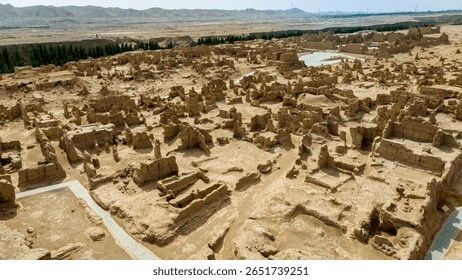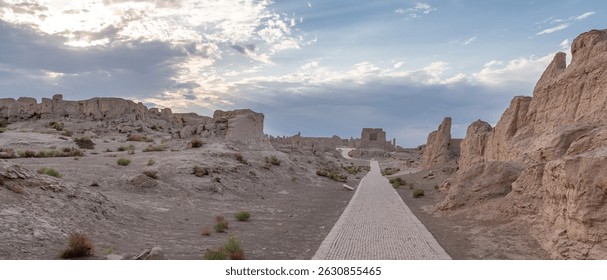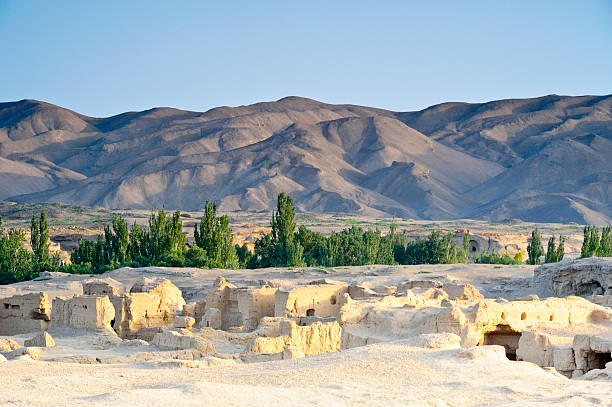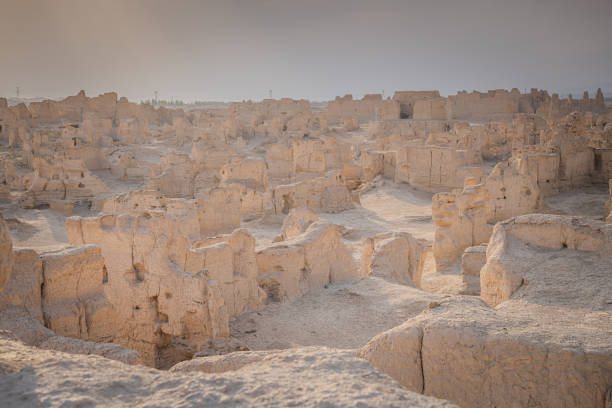The Fascinating History of Shijiahe Ruins: Insights into Early Chinese Society

An Essential Guide to Visiting Shijiahe Ruins
In This Guide
- An Essential Guide to Visiting Shijiahe Ruins
- The Rich History and Legends of Shijiahe Ruins
- Main Highlights: What You Absolutely Can’t Miss
- Planning Your Visit: A Practical Guide
- Tickets: Prices, Booking, and Tips
- How to Get There: A Complete Transportation Guide
- Local Cuisine and Accommodation Nearby
- Frequently Asked Questions
- Final Thoughts on Your Trip
Unveiling the Secrets of Shijiahe Ruins
Nestled in the serene landscapes of Hubei province, the Shijiahe Ruins (石家河遗址) stand as a remarkable testament to China’s rich history, dating back over 7,000 years. This archaeological site, located near the town of Tianmen, offers a rare glimpse into the life of a sophisticated Neolithic civilization that thrived during the early stages of Chinese civilization.
As you step into the Shijiahe Ruins, you are not just walking through remnants of ancient structures; you are traversing the pathways of time, discovering the remnants of a complex society that once flourished here. The site has yielded an impressive collection of artifacts, including stone tools, pottery, and bronze implements, hinting at the advanced skills of its inhabitants. The discovery of the 陶祖 (Tao Ancestor), a distinctive artifact from the patrilineal clan society, adds layers of cultural significance to this already profound site.

Shijiahe Ruins.
Why Visit Shijiahe?
– Historical Significance: Recognized as one of the largest Neolithic village sites in southern China, it showcases the artistic and cultural value of early Chinese societies.
– Unique Artifacts: Thousands of artifacts, including rice grains, pottery, and tools, have been unearthed, providing insight into the daily lives and practices of its ancient people.
– Cultural Experience: Engaging with this site allows travelers to immerse themselves in the rich tapestry of Chinese history and understand the evolution of its civilization.
Planning Your Visit
When visiting the Shijiahe Ruins, be prepared to explore not only the archaeological features but also the breathtaking landscapes surrounding the site. The experience is enriched by local guides who can share their knowledge of the site’s significance and the stories behind its discoveries.
As you wander through these ancient remnants, take a moment to reflect on the lives of those who walked this land thousands of years ago. The Shijiahe Ruins are more than just a destination; they are a journey into the heart of China’s history, waiting to be discovered by those who seek to understand the past.

Shijiahe Ruins.
The Rich History and Legends of Shijiahe Ruins
The Shijiahe Ruins, located in Hubei province near the town of Tianmen, are not only a significant archaeological site but also a window into the rich tapestry of ancient Chinese civilization. Dating back over 7,000 years, they are recognized as one of the largest Neolithic village sites in southern China, revealing layers of history that speak to the development of early human societies and their cultural practices.
A Glimpse into Ancient Life
Discovered during the late 20th century, the Shijiahe site has yielded an impressive array of artifacts, including stone tools, pottery, bone implements, and bronze items. These finds provide invaluable insights into the daily lives, agricultural practices, and artistic expressions of the inhabitants. Among the most noteworthy discoveries is the “Pottery Ancestor” artifact, a significant emblem of the patrilineal clan system during primitive society. This finding underscores the importance of ancestral worship and the social structures that defined early communities.

Shijiahe Ruins.
The excavation of Shijiahe has revealed evidence of complex societal organization, advanced agricultural techniques, and trade networks. The presence of rice husks and other agricultural remnants indicates that the inhabitants engaged in rice cultivation, which was a cornerstone of their economy and sustenance. Such advancements illustrate the ingenuity of ancient peoples in adapting to their environment, laying the groundwork for future developments in Chinese civilization.
Legends and Cultural Significance
The Shijiahe Ruins are steeped in local legends that enrich their historical significance. According to folklore, the area is associated with the mythical figure of the Yellow Emperor, a legendary ruler in Chinese history often credited with uniting the tribes of ancient China. Tales suggest that the early inhabitants of Shijiahe were descendants of this great leader, further embedding the site in the mythos of Chinese identity.

Shijiahe Ruins.
Moreover, the site is often viewed as a spiritual place, where the ancestors of the region are believed to have thrived. Local traditions maintain that the spirits of these early peoples still inhabit the land, offering a sense of continuity between past and present. This belief fosters a deep respect for the site, as it symbolizes not only the historical lineage of the people but also their cultural heritage.
The Artistic Legacy
The artistic artifacts discovered at Shijiahe are of exceptional value, showcasing the creativity and craftsmanship of its ancient people. The pottery, often intricately decorated with geometric patterns and motifs, reflects a sophisticated understanding of aesthetics and utility. These vessels were not merely functional; they served as expressions of cultural identity and artistic innovation.
The significance of Shijiahe extends beyond its archaeological importance; it serves as a cultural touchstone that connects modern Chinese society with its ancestral roots. Today, the site attracts scholars, historians, and tourists alike, eager to explore the remnants of a civilization that flourished thousands of years ago.

Shijiahe Ruins.
Visiting the Shijiahe Ruins
For travelers keen on exploring the depths of Chinese history, a visit to the Shijiahe Ruins offers a unique opportunity to walk in the footsteps of ancient peoples. The site is not only an archaeological wonder but also a living testament to the enduring legacy of China’s rich cultural heritage. As you wander through the remains of this once-thriving village, you will find yourself immersed in stories of resilience, innovation, and the timeless connection between past and present.
In summary, the Shijiahe Ruins represent a vital chapter in the history of humanity, illuminating the lives of those who lived long before us, their legends, and the artistic legacy that continues to inspire.

Shijiahe Ruins.
Main Highlights: What You Absolutely Can’t Miss
Discover the Riches of Shijiahe Ruins
Nestled in the picturesque Shihe Town of Tianmen, Hubei Province, the Shijiahe Ruins (石家河遗址) offer a fascinating glimpse into ancient Chinese civilization. As one of the largest Neolithic settlement sites in southern China, this archaeological treasure is a must-see for those keen on exploring the depths of Chinese history and culture. Here are the key highlights you absolutely cannot miss during your visit.
1. The Archaeological Significance
The Shijiahe site dates back over 7,000 years, making it a remarkable window into the past. Discovered between the 1970s and 1980s, thousands of artifacts were unearthed, including stone tools, pottery, and bronze items. This site is crucial for understanding the development of early agrarian societies in China.
2. Cultural Artifacts
The site boasts an impressive collection of relics that showcase the artistic and utilitarian skills of its inhabitants. Among the most notable finds are:
– Stone tools: Reflecting the craftsmanship of early humans.
– Pottery: Exquisite vessels that offer insight into the daily lives of the Shijiahe people.
– Bronze artifacts: These items highlight the technological advancements of the time.
– Rice remains: Evidence of early agriculture, showcasing the transition from hunter-gatherer societies to settled farming communities.

Shijiahe Ruins.
3. The Pottery Kiln
One of the standout features of the Shijiahe Ruins is the ancient pottery kiln discovered on-site. This kiln is a testament to the advanced pottery-making techniques of the era. Visitors can marvel at the structure and imagine the skilled artisans who operated it, producing functional and decorative items for their community.
4. The Historic Village Layout
Exploring the remnants of the village layout provides a tangible sense of community life in ancient times. Walk through the remains of circular and square houses, and envision how people lived, interacted, and thrived in this Neolithic settlement. The layout is a fascinating study in early urban planning, reflecting social organization and communal living.

Shijiahe Ruins.
5. Educational Exhibits
The Shijiahe Museum, located nearby, enhances the experience with informative displays. Here, you can explore detailed exhibits about the site’s history, the people who lived there, and the artifacts discovered during excavations. Interactive installations and guided tours provide context and deepen your understanding of this ancient civilization.
6. Scenic Surroundings
The ruins are set against a backdrop of stunning natural beauty. The surrounding landscapes of Hubei Province, with their lush greenery and tranquil rivers, create a serene environment perfect for reflection after immersing yourself in history. Take the time to enjoy a leisurely walk in the area to appreciate its scenic charm.

Shijiahe Ruins.
7. Local Culture and Cuisine
While visiting Shijiahe, don’t miss the opportunity to engage with the local culture. Sample regional delicacies at nearby eateries, where you can savor traditional Hubei dishes. This culinary experience offers a delightful taste of local flavors, enriching your journey through history.
Conclusion
The Shijiahe Ruins stand as a testament to the ingenuity and resilience of early Chinese societies. With its historical significance, rich artifacts, and beautiful surroundings, a visit to this site is not only a journey into the past but also an enriching cultural experience. Prepare to be captivated by the stories that these ancient ruins tell, making it an unmissable destination for history buffs and cultural enthusiasts alike.
Planning Your Visit: A Practical Guide
Your Essential Guide to Visiting the Shijiahe Ruins
Nestled in the heart of Hubei Province, the Shijiahe Ruins offer a fascinating glimpse into ancient Chinese civilization. This archaeological site, which dates back over 7,000 years, is a treasure trove for history enthusiasts and cultural travelers alike. Here’s everything you need to know to make your visit enriching and enjoyable.

Shijiahe Ruins.
Getting There
Location:
The Shijiahe Ruins are located in Shihe Town, Tianmen City, Hubei Province, China. The site is easily accessible from major cities in the region, including Wuhan.
Transportation Options:
– By Train: Take a train to Tianmen from Wuhan; the journey typically takes around 1.5 to 2 hours. Once in Tianmen, local taxis or rideshare services can take you to Shihe Town.
– By Car: Renting a car provides flexibility. The drive from Wuhan to Shijiahe takes approximately 1.5 hours.
– Guided Tours: Consider booking a guided tour from Wuhan, which may include transportation, a knowledgeable guide, and additional sites of interest.

Shijiahe Ruins.
Best Time to Visit
Seasons:
The ideal time to visit Shijiahe is during the spring (March to May) and autumn (September to November) when the weather is mild. Summers can be hot and humid, while winters might be chilly.
Opening Hours:
The site is generally open to visitors from 8:00 AM to 6:00 PM. It’s advisable to arrive early to avoid crowds and to have ample time to explore.

Shijiahe Ruins.
What to Expect
Site Features:
– Excavation Sites: Walk through the remains of this ancient village, where thousands of artifacts, including pottery, stone tools, and bronze items, were discovered.
– Cultural Exhibits: The site features informative displays that explain the significance of the artifacts and the lifestyle of the Neolithic communities that once thrived here.
– Scenic Views: The surrounding landscape offers beautiful vistas, perfect for photography and enjoying the tranquility of the area.
Tips for Your Visit
- Wear Comfortable Shoes: The terrain can be uneven, so sturdy footwear is recommended.
- Bring Water and Snacks: There are limited facilities at the site, so plan ahead to stay hydrated and energized.
- Photography: Capture the beauty of the ruins and the surrounding countryside, but be respectful of any signs regarding photography restrictions.
- Engage with Local Guides: If possible, hire a local guide to gain deeper insights into the history and cultural significance of the ruins.
Nearby Attractions
- Lu Yu Square: Located in Tianmen, this square is a great place to experience local culture and cuisine.
- Hubei Provincial Museum: A short trip from Shijiahe, this museum houses numerous artifacts from various periods of Chinese history.
Accommodations
Where to Stay:
While options are limited in Tianmen, you can find various accommodations, from budget hotels to more comfortable inns. Booking in advance is recommended, especially during peak tourist seasons.
Recommended Hotels:
– Local inns and guesthouses provide a cozy experience.
– Look for hotels with good reviews for cleanliness and service.
Final Thoughts
Visiting the Shijiahe Ruins is not just about seeing ancient artifacts; it’s about stepping back in time to understand the roots of Chinese civilization. With proper planning and an open mind, you will undoubtedly leave with a profound appreciation for this remarkable piece of history. Enjoy your journey into the past!
Tickets: Prices, Booking, and Tips
Planning Your Visit to the Shijiahe Ruins
If you’re eager to explore the Shijiahe Ruins, a treasure trove of ancient Chinese history, understanding the ticketing process is crucial for a smooth visit. Below, you’ll find essential information regarding ticket prices, booking methods, and helpful tips to enhance your experience.
Ticket Prices
- General Admission: Approximately ¥30 (about $4) per person.
- Discounted Rates: Reduced tickets may be available for students and seniors. Always bring valid identification to benefit from these discounts.
- Guided Tours: For a more immersive experience, consider joining a guided tour. Prices can vary but generally start around ¥150 (about $22), which may include transportation and expert commentary.
Booking Your Tickets
- On-site Purchase: Tickets can be purchased directly at the Shijiahe site entrance. It’s advisable to arrive early, especially during weekends and holidays, to avoid long lines.
- Online Reservations: Some tour operators offer online booking options that bundle tickets with additional services, such as guided tours or transportation from nearby cities like Wuhan. Websites such as TripAdvisor or Viator can be excellent platforms for these packages.
- Local Tour Agencies: If you prefer a customized experience, consider reaching out to local travel agencies in Tianmen or Wuhan. They can assist in arranging private tours that include Shijiahe and other historical sites in the region.
Tips for a Great Visit
- Best Time to Visit: Aim for the early morning or late afternoon to enjoy cooler temperatures and softer lighting for photography. The ruins are also less crowded during these times.
- Wear Comfortable Footwear: The site involves walking over uneven terrain, so sturdy, comfortable shoes are a must.
- Bring Water and Snacks: While there may be limited food options nearby, having water and light snacks on hand will help keep your energy up as you explore.
- Leverage Local Guides: Engage with local guides who can provide deeper insights into the cultural significance of the artifacts and the site itself. Look for licensed guides at the entrance or through reputable tour companies.
- Respect the Site: As a UNESCO-recognized historical site, it’s essential to follow the rules regarding photography and artifact handling to preserve its integrity for future generations.
By planning ahead and considering these tips, your visit to the Shijiahe Ruins will not only be enjoyable but also enriching, allowing you to connect with the fascinating history of ancient China.
How to Get There: A Complete Transportation Guide
Navigating Your Way to Shijiahe Ruins
Visiting the Shijiahe Ruins (石家河遗址) is a remarkable journey into China’s rich history, particularly the Neolithic era. Situated in Shihe Town, near Tianmen City in Hubei Province, this archaeological site offers travelers a glimpse of a civilization that thrived over 7,000 years ago. Here’s a comprehensive guide on how to get there, ensuring your trip is as smooth as it is enlightening.
Arrival by Air
Wuhan Tianhe International Airport (WUH) is the nearest major airport, located approximately 65 kilometers from the Shijiahe Ruins. This airport serves both domestic and international flights and is a convenient entry point for travelers.
- From the Airport to Tianmen:
- Taxi: The most straightforward option, taking about 1.5 hours. Expect to pay around ¥300-¥400 (approximately $45-$60).
- Airport Shuttle: Check for shuttle services that may offer rides to Tianmen. This can be a cost-effective alternative.
- Car Rentals: Various agencies operate at the airport, providing another flexible option to reach your destination.
Traveling from Wuhan to Tianmen
Once you arrive in Wuhan, you have several options to continue your journey to Tianmen, where the Shijiahe site is located.
- By Train:
-
High-Speed Train: The most efficient way to travel. High-speed trains run frequently from Wuhan Railway Station to Tianmen Railway Station. The journey takes about 40-50 minutes. Tickets can be purchased at the station or via online platforms, costing approximately ¥40-¥80 ($6-$12).
-
By Bus:
-
Long-Distance Bus: Buses from Wuhan’s major bus stations (like the General Bus Station) to Tianmen are available. The trip lasts about 1.5 to 2 hours, with fares ranging from ¥30-¥50 ($4-$8). Buses run regularly, but check the schedule in advance.
-
By Private Car:
- If you prefer more comfort, consider hiring a private transfer service or taxi for a direct trip. This option allows for greater flexibility, especially if you wish to explore the area at your own pace.
Local Transportation in Tianmen
Once you arrive in Tianmen, getting to the Shijiahe Ruins is relatively easy.
- Public Transport:
-
Local Buses: Buses operate from Tianmen city center to Shihe Town. This is an economical choice, though it may require some navigation.
-
Taxis and Rideshare:
-
Taxis are readily available and can be hailed from anywhere in the city. A ride to the Shijiahe Ruins from the city center typically costs around ¥30-¥50 ($4-$8). Rideshare apps such as Didi are also operational in the area.
-
Bicycles and Walking:
- For the more adventurous traveler, renting a bicycle can be a delightful way to explore the scenic surroundings. Alternatively, if you prefer to walk, the site is accessible on foot from certain parts of Tianmen.
Tips for a Smooth Journey
- Language: While major transport hubs may have English signage, knowing a few basic Mandarin phrases can be helpful, especially in smaller towns.
- Cash: Although mobile payments are widely accepted in China, it’s advisable to carry some cash for local transport and small purchases.
- Timing: Plan your travels to avoid peak hours, especially when using public transport, to ensure a more comfortable experience.
By following this guide, international travelers can confidently navigate their way to the Shijiahe Ruins, immersing themselves in the profound history and culture that this remarkable site has to offer. Enjoy your journey through time!
Local Cuisine and Accommodation Nearby
Dining Delights and Comfortable Stays Near Shijiahe Ruins
When exploring the Shijiahe Ruins, a site rich in history and cultural artifacts from over 7,000 years ago, visitors can enhance their experience by indulging in local cuisine and finding suitable accommodations nearby.
Local Cuisine
The culinary landscape around the Shijiahe Ruins reflects the flavors of Hubei Province, known for its diverse and hearty dishes. Here are some must-try local specialties:
-
Wuhan Hot Dry Noodles (热干面): This iconic dish features wheat noodles tossed in sesame paste, pickled vegetables, and a sprinkle of chopped scallions. It’s a popular breakfast option, providing a hearty start to your day of exploration.
-
Steamed Fish (清蒸鱼): Freshwater fish, often sourced from the nearby Yangtze River, is delicately steamed with ginger and scallions, retaining its natural flavors. This dish embodies the essence of Hubei’s culinary philosophy—simple yet exquisite.
-
Diced Chicken with Peanuts (宫保鸡丁): A spicy and savory dish featuring diced chicken, peanuts, and vegetables, it showcases the region’s love for bold flavors combined with a hint of sweetness.
-
Sour Fish Soup (酸鱼汤): This unique soup incorporates local fish with sour ingredients, offering a refreshing contrast that is both nourishing and invigorating.
-
Local Snacks: Don’t miss street food vendors offering Sijimei (四季美) dumplings, which are filled with a variety of ingredients from pork to vegetables, and Tianmen Rice Cakes (天门米糕), a sweet treat made from glutinous rice.
Nearby Accommodations
After a day of immersing yourself in the ancient wonders of Shijiahe, a comfortable place to rest is essential. Here are some accommodation options that cater to various preferences:
-
Tianmen Hotel (天门宾馆): A reliable choice for international travelers, this hotel offers modern amenities, comfortable rooms, and easy access to local attractions. Its on-site restaurant serves a mix of Western and Chinese cuisine.
-
Hubei Tianmen International Hotel (湖北天门国际大酒店): This upscale hotel features spacious rooms and elegant decor. Guests can enjoy a range of dining options and wellness facilities, making it a perfect retreat after a day of exploration.
-
Tianmen City Inn (天门城市旅馆): A budget-friendly option, this inn provides cozy accommodations with essential amenities. It’s conveniently located near public transport, making it easy to explore the surrounding area.
-
Local Guesthouses: For a more intimate experience, consider staying in a local guesthouse. These often provide a glimpse into daily life in Tianmen, with home-cooked meals and friendly hosts eager to share their culture and stories.
Conclusion
The Shijiahe Ruins not only offer a fascinating glimpse into ancient civilization but also provide travelers with an opportunity to experience the local culture through its cuisine and hospitality. Whether you’re savoring a bowl of hot dry noodles or resting in a cozy inn, your journey will be enriched by the flavors and warmth of Tianmen.
Frequently Asked Questions
Common Inquiries About the Shijiahe Ruins
1. What are the Shijiahe Ruins?
The Shijiahe Ruins, located near Shihe Town in Tianmen, Hubei Province, are a significant archaeological site dating back over 7,000 years. This Neolithic settlement is renowned for its remarkable artifacts, including stone tools, pottery, and bronze items, showcasing the advanced culture of early agricultural societies in southern China.
2. How can I reach the Shijiahe Ruins?
The Shijiahe Ruins are accessible from Wuhan, the capital of Hubei Province. You can take a private car or join a guided tour for a seamless experience. Public transportation options may also be available, but it’s advisable to check local bus schedules for the best routes to Tianmen.
3. What can I expect to see at the site?
Visitors to the Shijiahe Ruins can explore the remnants of ancient structures, view an impressive collection of artifacts on display, and learn about the site’s historical significance through informative signage. The site offers a glimpse into the lives of a primitive tribe that thrived in this region thousands of years ago.
4. Is there an entrance fee for the Shijiahe Ruins?
Currently, the entrance to the Shijiahe Ruins is free, making it an excellent destination for travelers interested in history and culture without the burden of admission costs. However, it’s prudent to check for any updates or changes before your visit.
5. Are there guided tours available?
Yes, several local tour operators offer guided tours that include the Shijiahe Ruins along with other nearby attractions in Tianmen and Wuhan. These tours often provide in-depth historical context and insights that can enhance your understanding of the site.
6. What is the best time to visit?
The ideal time to visit the Shijiahe Ruins is during the spring (March to May) and autumn (September to November) when the weather is pleasant, making it comfortable for exploration. Summer can be hot and humid, while winter may bring colder temperatures.
7. What should I bring while visiting?
When visiting the Shijiahe Ruins, it’s wise to bring comfortable walking shoes, water, and a camera to capture the stunning archaeological features. A hat and sunscreen are also recommended, especially if you’re visiting during the warmer months.
8. Are there any facilities available at the site?
The Shijiahe Ruins are primarily an outdoor archaeological site, so facilities are limited. However, there may be basic amenities such as restrooms nearby. It’s advisable to plan accordingly and bring any necessary supplies, such as snacks or drinks, for your visit.
Final Thoughts on Your Trip
As you conclude your journey through the ancient echoes of the Shijiahe Ruins, allow yourself to reflect on the remarkable tapestry of human history woven into this site. Nestled in the picturesque Tianmen region of Hubei province, the Shijiahe Ruins are not just remnants of a bygone era; they are a testament to the ingenuity and resilience of the Neolithic people who thrived here over 7,000 years ago.
Key Takeaways from Your Visit:
-
Cultural Significance: The artifacts unearthed at Shijiahe, ranging from stone tools to pottery and bronze implements, reveal the sophisticated society that once flourished. Each piece tells a story, offering insights into the daily lives, artistic expression, and spiritual beliefs of its inhabitants.
-
A Journey Through Time: Walking among the ruins, you’ve experienced the palpable connection between the past and present. The site stands as a vivid reminder of the enduring legacy of humanity and the cultural richness that has shaped China over millennia.
-
Engagement with Local Heritage: By visiting Shijiahe, you’ve not only explored a significant archaeological site but also engaged with the local community and its efforts to preserve this invaluable heritage. Your presence supports the ongoing promotion and appreciation of these cultural treasures.
As you prepare to leave, take a moment to absorb the serene surroundings and the whispers of history that linger in the air. Whether you are an avid historian, a culture enthusiast, or simply a curious traveler, the Shijiahe Ruins offer a unique window into the ancient world, inviting you to ponder the complexities of human civilization.
Your visit to this extraordinary site is just one chapter in your broader exploration of China—a country rich in history, culture, and unparalleled beauty. We hope that the memories you’ve created here will inspire further adventures and a deeper understanding of the stories that shaped this remarkable land. Safe travels!